
9 Detoxifying Indoor Plants That Are Hard To Kill

Posted on 11 Nov, 2019

We spend more than 90 percent of our time indoors. Rather disturbingly, indoor air pollutants have been ranked among the top five environmental risks to public health. Furnishings, upholstery, synthetic building materials, and cleaning products in homes and offices can emit a variety of toxic compounds, like formaldehyde.Indoor air pollution can also be caused by pollen, bacteria, and mold.
There has been lots of research that has been done on ways to purify our air, including some by NASA. One of the challenges they have faced is in keeping good air quality aboard a spacecraft. NASA scientists have worked hard to understand this problem and find solutions. Their answer was an easy one: Use houseplants to clean the air.
Adding potted plants to a room has been shown to reduce the amount of air particulates. Plants absorb some of the particulates from the air at the same time that they take in carbon dioxide, which is then processed into oxygen through photosynthesis. But that’s not all—microorganisms associated with the plants are present in the potting soil, and these microbes are also responsible for much of the cleaning effect.
Beyond air quality, plants just make people feel better. For example, hospital patients with plants in their rooms were more positive and had lower blood pressure and stress levels.
Unfortunately, buying plants for your home is one thing. Keeping them alive is another. Here's a list of robust indoor plants that should work for you.
1. Garden Mum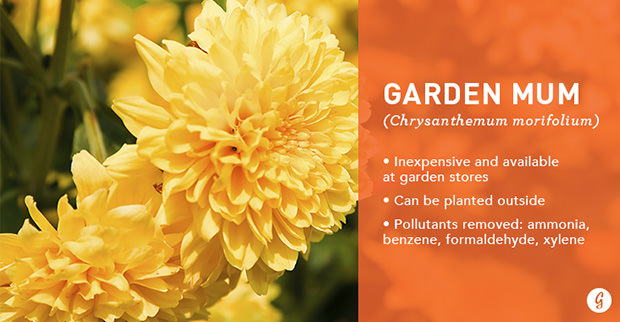
In the NASA research, this plant was an air-purifying champion, removing ammonia, benzene, formaldehyde, and xylene from indoor air. Popular and inexpensive at garden stores, they can be planted outside after they're finished blooming.
Pollutants removed: ammonia, benzene, formaldehyde, and xylene
2. Spider Plant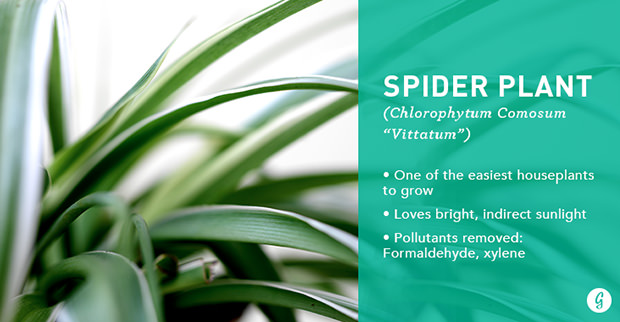
Spider plants are among the easiest houseplants to grow, making them a great choice for beginners or forgetful owners. A fan of bright, indirect sunlight, spider plants will send out shoots with flowers that eventually grow into baby spider plants or spiderettes.
Pollutants removed: formaldehyde and xylene
3. Dracaena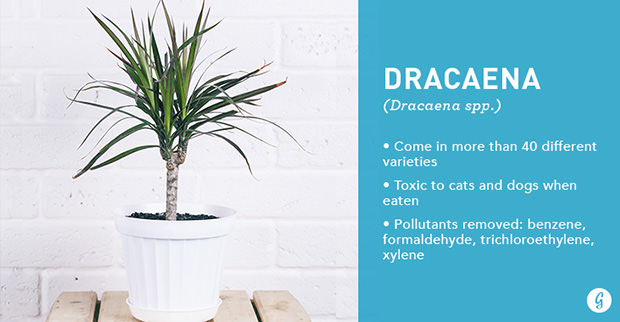
There are more than 40 different kinds of Dracaena plants, making it easy to find one that’s a perfect fit for your home or office. They're common foliage plants with long, wide leaves that are often variegated with lines of white, cream, or red. Pet owners might want to select a different plant, however, as these are toxic to cats and dogs.
Pollutants removed: benzene, formaldehyde, trichloroethylene, and xylene
4. Ficus/Weeping Fig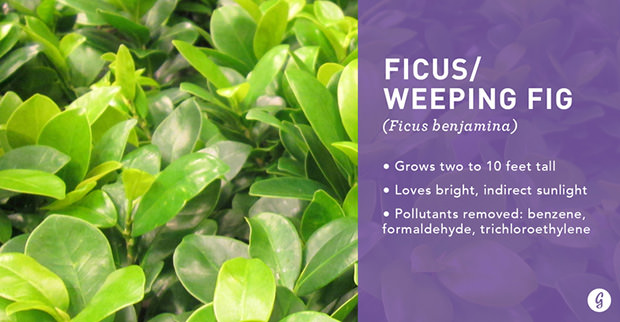
Though the ficus is a tree in its native home of southeast Asia, when it grows indoors, it's a hardy plant that ends up being between two and 10 feet tall. So why not get figgy with it? Grow this low-maintenance houseplant in bright, indirect light and allow the soil to dry out between waterings. Although this plant has some serious air-cleaning abilities, it can also be taken outside in late spring and brought back indoors when temperatures are warm and well above freezing.
Pollutants removed: benzene, formaldehyde, and trichloroethylene
5. Peace Lily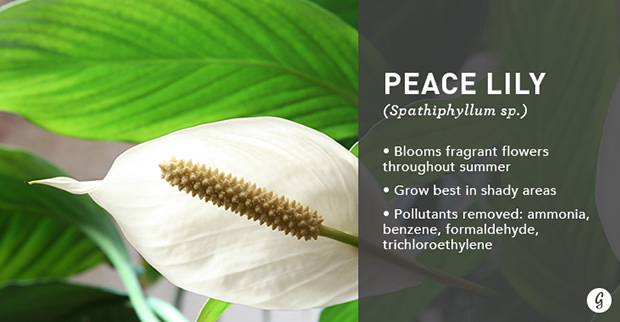
Peace lily plants are relatively small compared to many of the plants on this list, but they still pack some major air-cleaning abilities. Easy to grow, these plants will flower for much of the summer. Just be aware that those flowers (like all flowers) do contribute some pollen and floral scents to the air, so you may want to avoid having a room full of them. Put peace lilies in a shady spot and keep the soil moist without overwatering.
Pollutants removed: ammonia, benzene, formaldehyde, and trichloroethylene
6. Boston Fern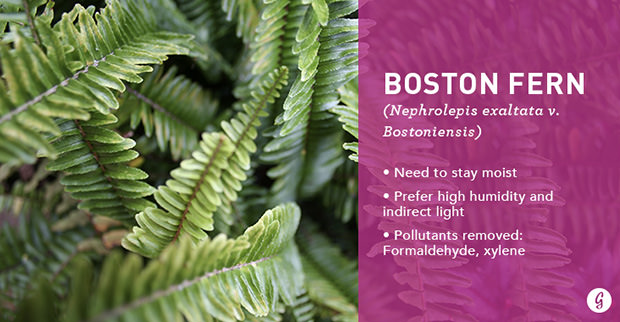
These plants prefer to clean the air from a cool location with high humidity and indirect light. They're relatively easy to grow, but they do need to stay moist. Check the Boston Fern’s soil daily to see if it needs water, and give it a good soak once per month.
Pollutants removed: formaldehyde and xylene
7. Snake Plant/Mother-in-Law’s Tongue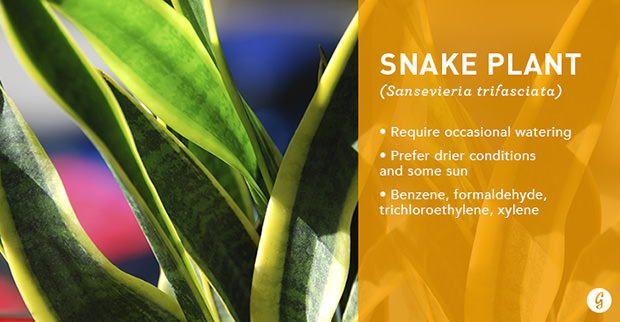
This is one of the hardest houseplants to kill. Although it does need to be watered occasionally, it generally prefers drier conditions and some sun.
Pollutants removed: benzene, formaldehyde, trichloroethylene, and xylene
8. Bamboo Palm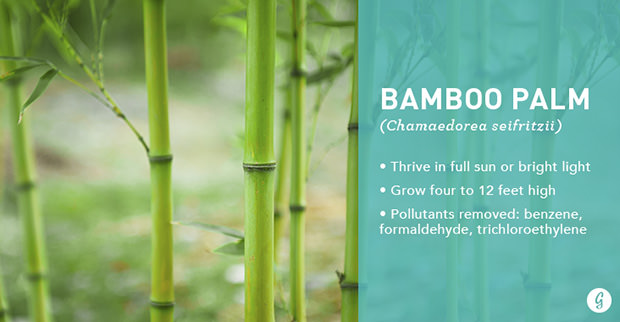
A superstar of filtering formaldehyde, these palms thrive in full sun or bright light. Part of the reason they can filter so much air is that they can grow to be pretty big—as tall as four to 12 feet high, making them exciting (and pet-friendly) indoor additions.
Pollutants removed: benzene, formaldehyde, trichloroethylene
9. Aloe Vera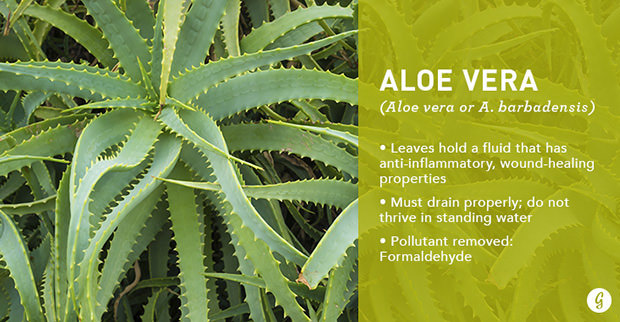
In addition to being easy to care for, aloe makes some serious health claims. The plant's leaves contain a clear liquid full of vitamins, enzymes, amino acids, and other compounds that have wound-healing, antibacterial, and anti-inflammatory properties, and there is some evidence that aloe may help (and is unlikely to hurt) skin conditions like psoriasis.
Pollutant removed: formaldehyde
Adapted from an article by Maria Janowiak on Greatist
Home And Living Books We Love

by Beth Greer

by B. C. Wolverton

by Christopher Gavigan

 Your Soulmate Is Not Who You Think It Is
Your Soulmate Is Not Who You Think It Is First World Problems
First World Problems How Stress Can Be Good For You
How Stress Can Be Good For You Tips To Quit Smoking
Tips To Quit Smoking










